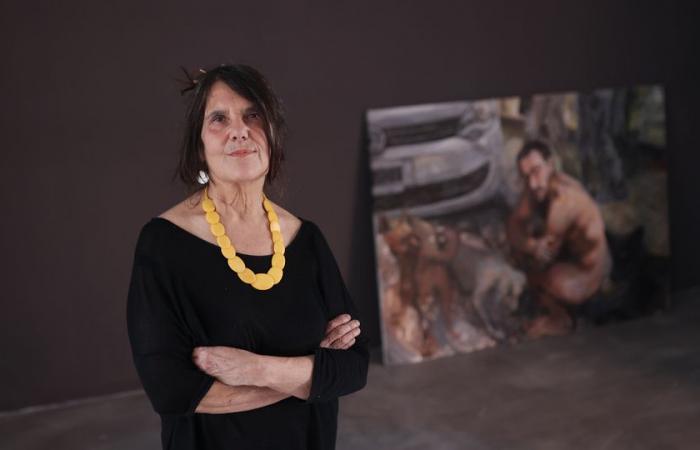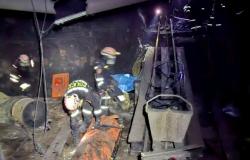“A picture ends when you believe it” Alejandra Fenochio says while running on the second floor of the Museum of Fine Arts, she is riding an anthology of her work from 2001 to now, This last word is the one that chose with lxs curatorxs Carlos Herrera and Ana Longoni -To who calls the guardian angels- to name a sample that paints the night and the lighting, the neighborhood and the people, the street and the perspective, forming pairs that strive to lose the edges and mix, as a great orgy of acrylic.
Alejandra is an artist from the Barrio de la Boca with a differential attachment to the encounter with Otres, says that what she likes to inaugurate a sample in Fine Arts is to be able to bring people together: her virtue is to gather, the models of her paintings, to the neighborhood of the neighborhood, her friends already unknown, on the banks of the riachuelo and now in the museum: “My old woman with Alzheimer’s makes me nervous, not coming to Fine Arts. I want the inauguration to be a party, that they all come and then we are going to celebrate the neighborhood ”, that augury makes it magnificent in its species and unfolds its talent in as many layers as details has its work.
Ana Longoni and Alejandra Fenochio met in an exchange of messages by Facebook today they make up this trio with Carlos Herrera who has been closely following the artist’s brushstrokes: “She paints the night but does not keep the dark but investigates the idea of the nightly,” says Herrera while accommodating the immense paintings in a room specially prepared on the second floor of the Fine Arts.
The exhibition that opens next Tuesday, May 6 She has three nuclei, from her 2001 monochromatic paintings where she appears with her family by stirring the garbage in a container, through the portrait to her friend Angy, a Brazilian with her breasts in the wind in a sea sea raft, also the infallible meticulous landscape of her mouth until she reaches the series “Street” that exposed post Pandemia in the Munar art gallery, huge canvases with characters that Alejandra enters through the look to display scenes that move. Those same paintings have one of the stories that the painter likes to tell.
Bridge history
In July 2023 hung – together with local workers – Calle On the catwalk of the Nicolás Avellaneda bridge, he used a lagged ladder and mounted them: “Every day it crosses people from Maciel Island to go to work, study or shop”, Phenochio wrote in a post of Instagram of 2024. The plan was that the paintings stayed a month but were hung there for two years.
“The people who crossed the bridge every day and never sees pictures asked me why I took them out,” It is a message received by Ana Longoni from Alejandra when they disassemble the cadres of the catwalk to take them to Fine Arts. The message continued: “They told me that they had ‘afflicted’ of my paintings, that they crossed the bridge with their children talking about the paintings. They hugged me with incredible love, and they stayed with me until the end”
On May 1, he turned 63 and celebrated it as always on the street, this time he chose the banks of the Riachuelo well near the Avellaneda bridge, a way of celebrating that his work was there, the public picture within reach of the gaze of the fishermen, curatorxs and friends.
What a beautiful dreams
“Alejandra wakes up in the middle of the night and that is where he detects a light, right in the dark. He puts the target, notes a detail and lets the paintings breathe their own light,” says Ana Longoni in the curatorial text of Now And continue with a description of your own room/ workshop: “The artist’s workshop is both her bedroom, up there in the convent of the mouth where she has lived for decades, meters from the stream, surrounded by an excessive jungle, full of flora and fauna as independent and irredentant as she. The paintings that seem dark, at night they shine with their own light, unexpected.
“The face is what is going to unveil the rest, I miss on those faces as well as in the painting, I like to lose myself in the painting“Says in front of”Third Cord ” An acrylic paint on 180 x 200 cm fabric that portrays two solar kids whom he admires for “the wave that they put in life.” It is an intuitive perspective that Alejandra creates in scenes that flee to the catastrophe, such as those in motion dogs that appear in almost all their paintings, beings that escort and flutter people in this crusade for removing at night their most common sense of threatening.
“What happens with the white is that you do not know where it can go,” Alejandra talks about the light but also of that journey that in which he ventures every time with his own hands he arms the racks and the fabric, a handmade task as a starting point for each work. “When he arrived at the museum, he began to retouch those edges, imagine how they were all here” Longoni account against “Padded”, one of the last paintings that Alejandra of the Calle series painted, where dog and human melt between the weather and nudity, a dystopian scene without violence, a literal gesture to the present: “The paintings gathered (made between the 2001 and the current crisis) vibrate in an irrevocable/necessary/urgently called attention to what a few live meters here, stirring the garbage, cartoney to survive, lighting a fire to warm up, urinating on the sidewalk, sleeping outdoors, waiting for this to ever happen, ”says Longoni in the curatorial text. On those“ few ”meters, Alejandra operates a well -incarnate proximity, the distance is almost that of a caress.
Las passed
To close the exhibition – and how could it be otherwise – Alejandra chose a deck of feminist cards to play the trick, and so with the suburb tone promises a tournament with the It was passed In some mouth barcito. They are 50 that he made in pieces of cardboard that he found while spending the days at the hospital taking care of his mother and his dad. They are printed for the first time for this exhibition and there are drunkenness that juggled with the glasses, the warriors that go from one place to another with the swords, the mares that steal the gold and those that climb the britos. Alejandra displays them all on the floor breaking the protocol of how to manipulate a work of art in a museum because it is yours, bringing, touching, painting a love that more than for art is on the street.






